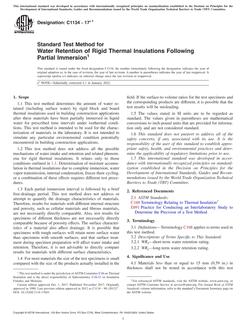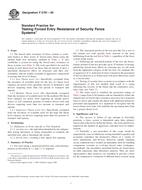1.1 One objective of a forensic glass examination is to compare glass samples to determine if they can be discriminated using their physical, optical or chemical properties (for example, color, refractive index (RI), density, elemental composition). If the samples are distinguishable in any of these observed and measured properties, it may be concluded that they did not originate from the same source of broken glass. If the samples are indistinguishable in all of these observed and measured properties, the possibility that they originated from the same source of glass cannot be eliminated. The use of an elemental analysis method such as inductively coupled plasma mass spectrometry yields high discrimination among sources of glass.
1.2 This test method covers a procedure for quantitative determination of the concentrations of magnesium (Mg), aluminum (Al), iron (Fe), titanium (Ti), manganese (Mn), rubidium (Rb), strontium (Sr), zirconium (Zr), barium (Ba), lanthanum (La), cerium (Ce), neodymium (Nd), samarium (Sm), and lead (Pb) in glass samples.
1.3 This procedure is applicable to irregularly shaped samples as small as 200 micrograms, for the comparison of fragments of a known source to the recovered fragments from a questioned source. These elements are present in soda lime and borosilicate glass in ppb to % levels
1.4 This procedure is applicable to other elements, other types of glass, and other concentration ranges with appropriate modifications of the digestion procedure (if needed for full recovery of the additional elements), calibration standards and the mass spectrometer conditions. Calcium and potassium, for example, could be added to the list of analytes in a modified analysis scheme. Alternative methods for the determination of concentrations of elements in glass are listed in the references.
1.5 For any given glass, approximately 40 elements are likely to be present at detectable concentrations using this procedure with minor modifications. The element set stated here is an example of some of these elements that can be detected in glass and used for forensic comparisons.
1.6 This guide cannot replace knowledge, skill, or ability acquired through appropriate education, training, and experience and should be used in conjunction with sound professional judgment.
1.7 The values stated in SI units are to be regarded as standard. No other units of measurement are included in this standard.
1.8 This standard does not purport to address all of the safety concerns, if any, associated with its use. It is the responsibility of the user of this standard to establish appropriate safety and health practices and determine the applicability of regulatory limitations prior to use.
Product Details
- Published:
- 06/15/2012
- Number of Pages:
- 7
- File Size:
- 1 file , 85 KB
- Redline File Size:
- 2 files , 170 KB


